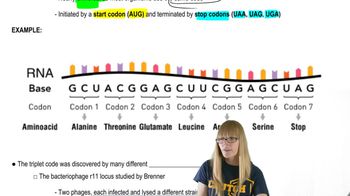Table of contents
- 1. Introduction to Genetics51m
- 2. Mendel's Laws of Inheritance3h 37m
- 3. Extensions to Mendelian Inheritance2h 41m
- 4. Genetic Mapping and Linkage2h 28m
- 5. Genetics of Bacteria and Viruses1h 21m
- 6. Chromosomal Variation1h 48m
- 7. DNA and Chromosome Structure56m
- 8. DNA Replication1h 10m
- 9. Mitosis and Meiosis1h 34m
- 10. Transcription1h 0m
- 11. Translation58m
- 12. Gene Regulation in Prokaryotes1h 19m
- 13. Gene Regulation in Eukaryotes44m
- 14. Genetic Control of Development44m
- 15. Genomes and Genomics1h 50m
- 16. Transposable Elements47m
- 17. Mutation, Repair, and Recombination1h 6m
- 18. Molecular Genetic Tools19m
- 19. Cancer Genetics29m
- 20. Quantitative Genetics1h 26m
- 21. Population Genetics50m
- 22. Evolutionary Genetics29m
17. Mutation, Repair, and Recombination
Types of Mutations
Problem 8c
Textbook Question
Textbook QuestionWhat is the difference between a silent mutation and a neutral mutation?
 Verified Solution
Verified SolutionThis video solution was recommended by our tutors as helpful for the problem above
Video duration:
47sPlay a video:
Was this helpful?
Key Concepts
Here are the essential concepts you must grasp in order to answer the question correctly.
Silent Mutation
A silent mutation is a change in the DNA sequence that does not alter the amino acid sequence of the resulting protein. This occurs due to the redundancy in the genetic code, where multiple codons can code for the same amino acid. As a result, silent mutations typically have no effect on the organism's phenotype and are often considered neutral in terms of natural selection.
Recommended video:
Guided course

Point Mutations
Neutral Mutation
A neutral mutation refers to a genetic change that does not confer any advantage or disadvantage to the organism's fitness. While silent mutations are a type of neutral mutation, not all neutral mutations are silent; some may change amino acids but still do not affect the organism's survival or reproduction. Neutral mutations can accumulate over time and contribute to genetic diversity without impacting evolutionary fitness.
Recommended video:
Guided course

Mutations and Phenotypes
Genetic Code Redundancy
Genetic code redundancy, also known as codon redundancy, is the phenomenon where multiple codons can specify the same amino acid. This feature of the genetic code allows for certain mutations, particularly silent mutations, to occur without affecting the protein produced. Understanding this redundancy is crucial for distinguishing between different types of mutations and their potential impacts on protein function and organismal traits.
Recommended video:
Guided course

The Genetic Code

 9:49m
9:49mWatch next
Master Point Mutations with a bite sized video explanation from Kylia Goodner
Start learning

